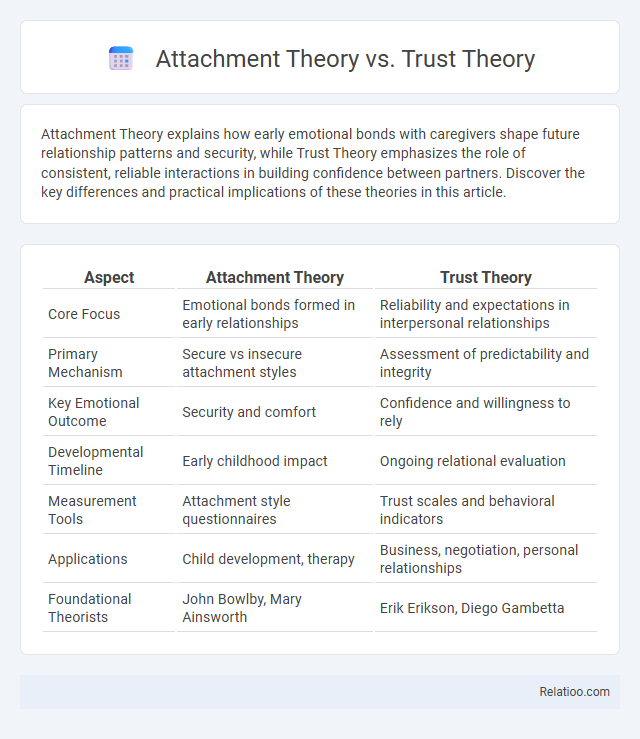Attachment Theory explains how early emotional bonds with caregivers shape future relationship patterns and security, while Trust Theory emphasizes the role of consistent, reliable interactions in building confidence between partners. Discover the key differences and practical implications of these theories in this article.
Table of Comparison
| Aspect | Attachment Theory | Trust Theory |
|---|---|---|
| Core Focus | Emotional bonds formed in early relationships | Reliability and expectations in interpersonal relationships |
| Primary Mechanism | Secure vs insecure attachment styles | Assessment of predictability and integrity |
| Key Emotional Outcome | Security and comfort | Confidence and willingness to rely |
| Developmental Timeline | Early childhood impact | Ongoing relational evaluation |
| Measurement Tools | Attachment style questionnaires | Trust scales and behavioral indicators |
| Applications | Child development, therapy | Business, negotiation, personal relationships |
| Foundational Theorists | John Bowlby, Mary Ainsworth | Erik Erikson, Diego Gambetta |
Understanding Attachment Theory: Foundations and Concepts
Attachment Theory, developed by John Bowlby, emphasizes the emotional bonds formed between infants and caregivers, highlighting the impact of these bonds on a child's development and future relationships. Trust Theory focuses on the establishment of trust as a foundational element in social and interpersonal contexts, often examining how trust evolves through consistent and reliable interactions. Understanding Attachment Theory involves recognizing key concepts such as secure, anxious, and avoidant attachment styles, which influence emotional regulation, social behavior, and mental health outcomes throughout life.
Exploring Trust Theory: Key Principles and Origins
Trust Theory, rooted in social psychology and relational dynamics, emphasizes the importance of predictability, reliability, and emotional security in forming strong interpersonal bonds. Unlike Attachment Theory, which centers on early child-caregiver relationships and emotional bonding patterns, Trust Theory focuses on cognitive evaluations and behavioral expectations in adult relationships. Understanding these key principles helps you build healthier connections by fostering transparency and mutual assurance.
Core Differences Between Attachment and Trust Theories
Attachment Theory centers on the emotional bonds formed in early relationships, emphasizing the security and comfort derived from caregivers. Trust Theory focuses on the expectation that others will act consistently and reliably, highlighting cognitive assessments of predictability and dependability. Understanding these core differences helps you recognize that attachment involves emotional connections, while trust is based on rational evaluations of reliability.
How Attachment Shapes Emotional Bonds
Attachment Theory explains how early emotional bonds formed between infants and caregivers create a framework for trust and interpersonal relationships throughout life. Trust Theory emphasizes the role of consistent and reliable interactions in developing secure connections, which are deeply influenced by these initial attachment experiences. Attachment shapes emotional bonds by fostering a secure base, enabling individuals to regulate emotions, build resilience, and form meaningful, lasting relationships.
The Role of Trust in Relationship Development
Trust plays a pivotal role in relationship development by providing a secure foundation that fosters emotional intimacy and stability, distinguishing it from Attachment Theory's focus on early bonds and emotional security. While Attachment Theory emphasizes the influence of early caregiver relationships on future attachments, Trust Theory highlights your ability to reliably predict a partner's behavior, which directly impacts relationship satisfaction and longevity. Understanding how trust builds over time through consistent actions allows individuals to strengthen attachments and cultivate deeper connections.
Childhood Experiences: Attachment vs Trust Formation
Childhood experiences play a crucial role in shaping both attachment and trust formation. Attachment Theory emphasizes the bond between a child and caregiver, highlighting how consistent responsiveness fosters secure attachments that influence emotional regulation and relationships throughout life. Trust Theory focuses on the development of confidence in others' reliability and intentions, suggesting that your early interactions provide the foundation for discerning trustworthiness in social connections.
Adult Relationships: Attachment Patterns vs Trust Dynamics
Attachment Theory in adult relationships highlights secure, anxious, and avoidant attachment patterns that influence emotional bonding and intimacy. Trust Theory focuses on the development and maintenance of trust dynamics, emphasizing reliability, vulnerability, and consistent behavior as foundations for relationship stability. Understanding the interplay between attachment patterns and trust dynamics is crucial for fostering healthy adult relationships and addressing conflicts effectively.
Psychological Impacts: Attachment Insecurity vs Trust Issues
Attachment insecurity often leads to difficulties in forming stable relationships, causing emotional distress and impaired social functioning. Trust issues can result in heightened anxiety, fear of betrayal, and decreased willingness to rely on others, affecting overall psychological well-being. Understanding these dynamics helps you address vulnerabilities in emotional bonds, promoting healthier interpersonal connections and resilience.
Application in Therapy: Attachment Theory and Trust Building
Attachment Theory emphasizes the importance of early relational bonds in shaping emotional security, which therapists use to help clients develop healthier interpersonal connections. Trust Theory focuses on establishing reliability and safety within the therapeutic relationship, crucial for fostering client vulnerability and openness. Your therapy sessions benefit by integrating both theories to create a secure environment that promotes trust and emotional attachment, essential for healing and growth.
Integrating Attachment and Trust Theories in Real Life
Integrating Attachment Theory and Trust Theory in real life enhances relationship dynamics by combining emotional bonds with reliability and dependability. Attachment Theory emphasizes the formation of secure emotional connections based on early caregiver interactions, while Trust Theory focuses on the cognitive assessment of reliability and integrity within relationships. By merging these frameworks, individuals can foster deeper interpersonal relationships grounded in both emotional security and consistent trustworthy behavior.

Infographic: Attachment Theory vs Trust Theory
 relatioo.com
relatioo.com